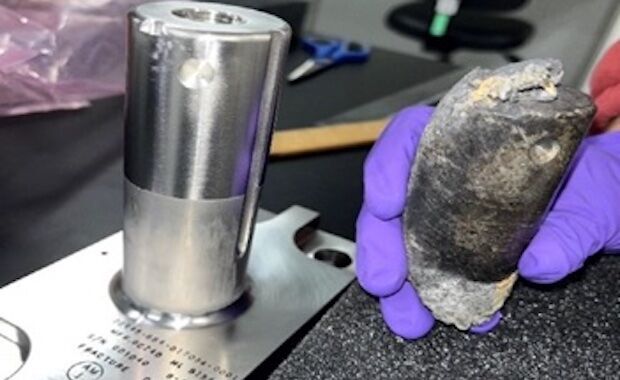Alejandro Otero, owner of the Naples, Florida, home struck by the debris, was not home when part of a battery pack from the International Space Station crashed through his home on March 8. His son Daniel, 19, was home but escaped injury. NASA has confirmed the 1.6-pound object, made of the metal alloy Inconel, was part of a battery pack jettisoned from the space station in 2021.
An attorney for the Otero family, Mica Nguyen Worthy, told Ars that she has asked NASA for “in excess of $80,000” for non-insured property damage loss, business interruption damages, emotional and mental anguish damages, and the costs for assistance from third parties.
“We intentionally kept it very reasonable because we did not want it to appear to NASA that my clients are seeking a windfall,” Worthy said.
Seems reasonable to me. If I accidentally caused damages to someone’s home, I’d certainly be held liable. But, I’m just some guy.
I love space stuff and NASA (one of the few truly great things about the US) but they really shouldn’t be yeeting things into orbit and hoping it takes care of itself.
See I would have thought nasa would reach out when they heard about it and straight up offered to pay for repairs. This case will surely settle outside of court for between $60k and $100k
So it was falling for three years
From my understanding, it was in orbit for three years before reentering our the atmosphere in an uncontrolled descent, then it fell through dude’s roof.
things in orbit are, technically, falling.
With style!
Is this true for everything in orbit though? Like, the ISS is in near earth orbit and so it’s absolutely just falling. But what about things up in a geostationary orbit? What about the moon?
Technically yes. The only thing keeping it near the object it’s orbiting is that objects gravity well. The only thing keeping the orbiting object from falling into the well is its speed.
Adding to @MaggiWuerze@feddit.de’s answer, an interesting tidbit: solar wind, particularly during more solar activity, blows (some of) Earth’s atmosphere all the way past the orbit of the Moon… so at some points in time, the Moon not only falls with style, but also falls through Earth’s atmosphere!
Depends on your reference frame
I’m in no way saying that your explanation is wrong, but I wanted to give a more bit-by-bit description so that anyone reading your comment doesn’t speculate or misconstrue how an ejected battery went from “orbit” to “uncontrolled descent”:
Everything we’ve put into that level of orbit is falling, it is just falling so slowly that it keeps missing the earth and only requires tiny bursts of energy to momentarily ascend away from earth. The battery didn’t get that burst of energy so it continued to descend around the earth until the pull of gravity was great enough in comparison to its forward motion that it appeared to go from a spiral to a more dramatic arc.
Once within the atmosphere, friction from the air slowed its forward motion while gravity continued accelerating it in a direction that everyone would agree is “downward.”
Everything we’ve put into that level of orbit is falling, it is just falling so slowly […] go from a spiral to a more dramatic arc […] Once within the atmosphere
This is not correct.
- Anything in orbit, is constantly free-falling at barely less than 9.8m/s².
- “Orbiting”, is having enough lateral momentum to keep missing the Earth.
- In the absence of an atmosphere, or any other external influence, an object would keep orbiting forever.
- However… Earth’s atmosphere doesn’t just end, it gets thinner and thinner instead… up to the Moon and beyond (thanks to the solar wind blowing it out)
- The reason for an object in LEO to “fall”, as in “decrease its orbital height”, is precisely because it’s been in Earth’s atmosphere all the time!
The reason for a “more dramatic arc”, is that as an objects looses orbital height, it keeps hitting ever denser atmosphere, until it ends up losing enough momentum to not be able to complete an orbit, which precipitates things (pun intended).
Thanks for the detailed explanation! That helps me understand it better myself. So basically, anything we put in orbit ourselves is always going to degrade, which requires routine positioning (i.e., expend some energy to keep the balloon in the air)?
Yes. In low orbit like the space station they mostly deal with atmospheric drag, even just gas molecules cause it. The ISS is has a “reboost” on a regular basis, often from arriving spacecraft but it can use onboard thrusters.
At much higher orbits the gravity of the sun, moon, differences in earths gravity, and even the tiny force of photons from the sun striking the spacecraft (solar radiation pressure) contribute orbital decay. The Vanguard I satellite was the fourth satellite in space and was expected to stay up for 2000 years, but thanks to solar radiation pressure and some atmospheric drag it’s more like 240.
Let me first state that I’m in no way an expert nor do I know much about the specifics of what you asked. Going in with this understanding, let’s do some overgeneralizing and sciencey handwaving:
Those are fantastic questions that get into really interesting concepts which I’m now going to title Types of Floating. Lemme clarify something: when I said “this level of orbit,” I was referring specifically to the ISS.
The ISS and many other satellites are in what is called “Low Earth Orbit,” with “low” being a relative term. If you stretched a rope around the Earth’s equator you’d have a rope that’s a little less than half of the average distance to the ISS. The orbit level of things is defined by the ranges of distance they travel around the earth, but by definition, they must go around the earth (if their orbit is defined to exist around the earth. You can orbit other celestial bodies too). So, imagine the lower earth orbits as something we lobbed hard enough into space that it’ll gradually reach the peak of its height before coming back down over the course of days to years. If you want that thing to stay in space longer, then you need to give it a boost every so often by ejecting some sort of matter. For example, if you were yeeted into Low Earth Orbit and while up there said “fuck my shoes” and kicked them off your feet, you’d change how long you were gonna stay in space! If you throw your shoes forward, you’ll slow yourself down and return sooner and if you threw them backwards, you’d stay longer! You wouldn’t cause that much of a time difference, but there it would be nonetheless.
So, if you can leave the earth at such a speed that you’ll return, could you enter space at a speed fast enough to never return? Absolutely! At a certain speed, future generations could use you as a landmark (spacemark?) on a trip out to the moon like a dead body on Space Everest. If you had been traveling any faster than that, then you could potentially fly an infinite distance away from the earth or possibly crash into the moon and have a crater named after your splattered body.
Now for the final part of your question: equating orbit to a balloon. If you’re referring to an air-filled balloon that slowly falls to the ground, but gently tapping it from below makes it float around a little longer, then no. If you’re talking about a helium-filled balloon that floats away until the helium escapes and it falls back to earth, then also no, but a different no. Both of these examples deal with density, but let’s start with the air-filled balloon.
The reason that a gentle push on the air-filled balloon is different is because orbit is determined by an object’s speed at which it circles the earth. If you want the ISS to go “higher,” you give it a push forward and it goes faster and thus expands its orbit. If you want it to go “lower,” then you push it backwards and by slowing down, its orbit gets closer to the earth. With the air-filled balloon, you can only keep it in the air longer by pushing up; if you blow air behind the balloon to make it move forward faster, it’ll land further away but in the same amount of time.
The reason air-filled balloons fall slowly though is because they weigh only slightly more than nothing and air weighs exactly the same amount as air. This means that the mass of the balloon exists over a larger area and has a reduced density compared to a deflated balloon. In fact, I’m sure someone with more patience than I have could calculate how much air you’d have to put into a human so that they’d gently fall like a dead, morbid balloon.
As for the helium-filled balloon, helium is so much less dense than air that there exists an amount of it which can offset the rubber membrane of a balloon. (Total side-note: the lower density of helium is what gives you a high-pitch voice when you talk on helium. I take a medication called ozempic which slows down my digestion—this means that when I eat something too greasy or have too much meat, my stomach acid will break down the meat to a point that I generate a considerable amount of hydrogen sulfide. This makes my burps smell of sulfur when that happens, but as the hydrogen evacuates the air from my larynx, my burp becomes higher and higher pitched like I’m on helium.) This significantly-reduced density for the balloon means that the balloon can float on the air like you can float in a pool. As a cool experiment, you can try inhaling and exhaling while you’re in a pool to note how much more you float when your lungs are filled with air. Just be careful not to breathe in water.
Anyway, you can see how in neither scenario does accelerating the balloon forward cause it to go higher.
Now, you might be wondering: when you’re so far away from the earth that it’s rotating at a different speed from you, how could you tell which direction is forward if you were floating in space? You could use the parallax of celestial bodies to figure out your vector, but I have no clue whatsoever how to do that. And that, the vast relative distances and speeds of objects in space is what scares the shit out of me whenever I imagine floating in space. That’s why I advocate for taking care of our pale blue dot floating through space: the nightmarish possibilities of leaving earth at any amount of wrong speed or timing could lead to becoming an unknown speck floating in an unknown region of neverending space. I’m not looking to Mars for salvation with that image in my brain.
Being in orbit is just falling with style.
deleted by creator
Yes
🤖 I’m a bot that provides automatic summaries for articles:
Click here to see the summary
The owner of a home in southwestern Florida has formally submitted a claim to NASA for damages caused by a chunk of space debris that fell through his roof in March.
NASA has confirmed the 1.6-pound object, made of the metal alloy Inconel, was part of a battery pack jettisoned from the space station in 2021.
“This is truly the first legal claim that is being submitted for recovery for damages related to space debris,” Worthy said.
Officials originally planned to place pallets of the old batteries inside a series of Japanese supply freighters for controlled, destructive reentries over the ocean.
In this case, the negligence could be that NASA miscalculated about the survival of enough debris to damage property on Earth.
Finally, NASA could refuse the claims or make an unacceptable settlement offer—in which case the Otero family could file a federal lawsuit in Florida.
Saved 80% of original text.
This is a great way to handle a tldr bot. Excellent idea, bot author.
80k seems like a lot of our tax dollars for this. But who am I to say.
I imagine it’ll be pretty ballpark after they bargain it down. You start higher than you need to in these negotiations.
Ahhh good point.
Way less than the police waste on unnecessary military equipment.
I dont disagree. But waste is waste.











